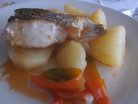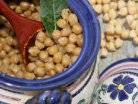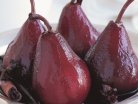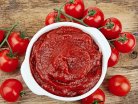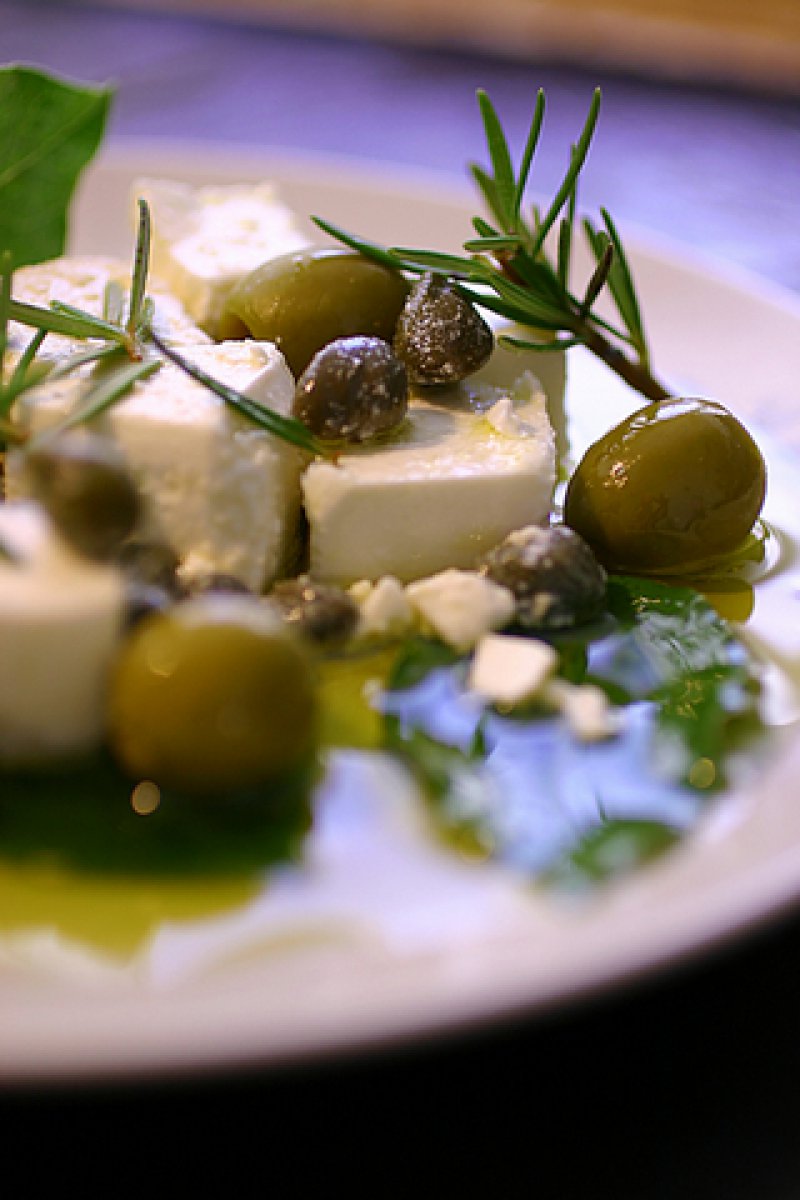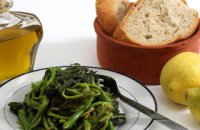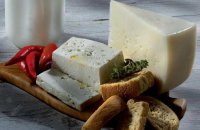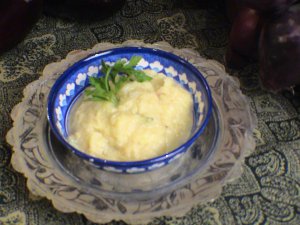For a product to be recognised as having a protected designation of origin (PDO)
- it must be produced and matured within a strictly predetermined geographical area
- the raw ingredients from which it is produced must come from the same area
- no chemical additives can be used during its manufacture
- it must be produced with traditional methods in natural conditions
There are 125 European cheeses characterised as PDO under Regulation 1107/96: 37 French, 30 Italian, 20 Greek, 11 Spanish, 10 Portuguese, 8 English, 3 German, 3 Danish, 2 Austrian, 1 Belgian.
The countries bordering the Mediterranean (and Portugal) account for 108 of the total of 125.
In a moment of exasperation with French politicking, Charles de Gaulle famously asked: “How can you govern a country that has 246 varieties of cheese?” Few would dispute that Greece is every bit as hard to govern as France, but cheese lovers outside the country only know feta and perhaps one or two other cheeses out of the multitude it offers. Yet, based on size and population, Greece produces as many different cheeses as France, confirming the general's observation!
Cheese is a very important food in Greece. It is served with almost every meal and enjoyed by young and old alike. The annual per capita consumption is about 25 kilos, more than in France or Italy, the other two cheese-loving European countries. There are 16 million sheep and goats in the country whose milk is used to produce cheese and yogurt. Each region has developed its own special varieties of cheese. Terrain, vegetation, microclimate, local animal breeds, and tradition all have influenced the evolution of local cheeses, which until recently were made by small dairies, by farmsteads, and even by shepherds. In many villages, families still make their own cheese with the milk of the household ewes and goats. The family cook is the cheese maker. Town and city folks have always looked for these local cheeses, the names of which traditionally indicate their provenance. For centuries, naming the type of cheese and its origin served the purpose of “branding”-- defining the product for the consumer.
Six of the PDO cheeses are quite soft, fine grained, and spreadable and are probably the oldest type of cheese ever made in Greece. Most are naturally coagulated and fermented, using rennet and native cultures, and are easy to produce, keep, and transport. They require no ageing and usually are eaten fresh. These cheeses are quite similar, fresh-tasting, slightly salty and tart, with an aroma reminiscent of fresh yogurt. Their individual character clearly reflects their origin, the “terroir” as the French would say. They are spread on bread or crackers, used as toppings, and as ingredients in pie fillings and in sauces. For a special treat, try any of them on a ripe, summer tomato-half with a sprinkling of oregano.
Although in the last decade several manufacturers have undertaken the commercial production of these cheeses, most are still made almost exclusively for personal consumption. They are produced during the summer, specifically in July and in August, just after the lactation period ends for goats and ewes. The milk is rich in solids then, and the weather is warm enough to expedite the souring and subsequent fermentation of the cheeses. Some of the cheeses acquire a pale hue as the bacteria propagate.
Anevato belongs to this category of soft, naturally fermented, very pungent Greek cheeses. It is produced in the towns of Grevena and Kozani in western Macedonia.
Anevato usually has a pinkish hue due to the bacteria that enable its fermentation. It is exceedingly sharp, in both flavor and aroma.
Galotyri, similar in flavor and texture to Anevato, is made in the traditional enclaves of the once itinerant shepherds who roamed mainland Greece: Epirus, in the northwestern part of the country, and Thessaly in the center.
Pychtogalo Chanion is a soft, smooth, white, slightly tart and lightly salted spreadable cheese that comes from Chania in western Crete. It is made with a blend sheep's and goat milk coagulated at low temperature with natural animal rennet. Pychtogalo means “thick- ened milk” and people in the region use it just that way. They spread it on country bread adding herbs and spices for a snack and include it in meat casseroles and sauces.
Katiki Domokou is made in Domokos, central Greece. A goat cheese, with some sheep's milk added occasionally, it is mild, slightly tart with texture and flavor reminiscent of strained yogurt. It is often eaten like yogurt and used as a topping for grilled and roasted meats.
Kopanisti, produced in the Cyclades islands of Mykonos, Tinos, and Syros, is grainier, sharper, and saltier than the soft naturally fermented cheeses of the mainland. It has complex, intense flavors and a characteristic pepperiness. It is often part of the meze menu offered with spirits such as tsipouro or with the dark, earthy, tannic wines of the Cyclades.
Xynomizithra of Crete differs from the other soft cheeses; it is a whey cheese, quite tart and low in butterfat content. The Cretans spread it on their renowned paximadia (rye and or barley rusks) and use it in tyropitas and kaltsounakia (cheese pies).
FETA AND OTHER PDO BRINE CHEESES
Feta, Kalathaki Limnou, Sfela and Batsos are all preserved in brine but other than that have little in common.
Feta is undoubtedly the favourite cheese of the Greeks; in fact, 70 percent of the cheese they consume is feta. It is also, arguably, the best known Greek cheese. By law, feta can be made only in the following specific regions: Macedonia, Thrace, Thessaly, Central Mainland Greece, the Peloponnese and Lesvos. The milk from which it is produced (up to 30 percent goat's milk is allowed by law to be mixed in with sheep's milk) has to come from animals that graze in the specific appellation of origin regions. There are many local variations which differ in creaminess, firmness, tartness, intensity of flavor and aroma. In general, cheese from the North (Macedonia and Thrace) is mild, softer and creamier, less salty with very few holes. Thessaly and Central Greece also produce creamy softer cheese but often with more intense flavor. The flavor of fresh milk comes through in the best made cheese. The
Peloponnese feta is firmer, “dryer,” with intense flavor and more holes in the mass of the cheese. Local conditions, cultures, animal breeds, and preferences are reflected in the local versions. Feta-lovers have their favourites and they can argue about it forever.
At its finest, feta suggests the flavor of fresh milk yet has the complexity that comes from special cultures creating subtle tastes and aromas over time. This aging process is best accomplished in beech-wood barrels. The cheese's refreshing but satisfying flavor and the balanced combination of tart- ness, richness and sweetness that comes from the creamy texture have made feta one of the world's most popular cheeses. True feta made by a master cheese maker with fresh sheep's milk and matured in a barrel is a very special luxury.
Kalathaki Limnou, from the northern Aegean island of Limnos, is made like feta but the curd is shaped into small, one-kilo (2.2-pound) heads in basketlike molds (kalathaki means small basket). Sheep’s milk with a maximum of 30% goat’s milk is used. Matured in brine, the little heads develop a special flavor. It is a table cheese, milder than feta with a pleasant taste and no evidence of ageing.
Sfela is a white cheese that looks like feta but is denser and saltier and acquires a special flavor when the curd is reheated after fine cutting. Aged in brine, either in wood or tin, it develops a characteristic piquant taste and mozzarella-like texture prized in its home territory around the town of Kalamata, where it is sometimes grilled.
Batsos is a rindless, semi-hard, low butterfat cheese made by hand churning the newly formed curd, forcing some of the butterfat into the whey. The low fat content gives the cheese a relatively dry mouth-feel and makes it ideal for grilling. Grilling or frying releases the buttery aromas of sheep's milk and makes a perfect meze with a drizzle of lemon juice. Batsos is produced in Thessaly as well as in Central and Western Macedonia and takes its name from the Vlach word for the thatched mountain hut in which it was traditionally produced, as one of the seasonal cheeses of itinerant shepherds in the north-western parts of Greece.
OTHER PDO CHEESES
Manouri, produced in Thessaly and Macedonia, is an unusual whey cheese made with the addition of fresh sheep's cream to the whey left after the production of hard cheese or feta. Its texture is smooth, dense, and buttery. It is shaped into logs by the cloth bags in which the curd drains. Very lightly salted, it retains the sweetness of the fresh cream. A delicious instant dessert can be created by spreading honey or fruit jam on a thin Manouri round and topping with a few chopped walnuts, almonds, or pistachios.
Kasseri is semi-hard with a unique, unmistakable flavor and buttery, pleasant texture. Kasseri is produced in the following PDO regions: Xanthi in Thrace, Macedonia, Thessaly, and on the island of Lesvos. The best is made from 100% sheep's milk, although goat's milk and up to 10% cow's milk may also be added. It belongs in the “pasta filata” family of cheeses; traditional kasseri is made by hand-kneading the warmed, malleable curd to just the right consistency. The master craftsman's skill plays a key role in the kneading and forming of the nine-kilo (20-pound) round heads and in the maturing process, in air at cellar temperature, for many months. The finished cheese shows complex flavors and buttery aromas. Kasseri is a wonderful table cheese to enjoy with full-bodied white wines.
Ladotyri Mytilinis, meaning “Oil Cheese from Mytiline,” gets its name from the fact that it is preserved in olive oil after ageing in air at cellar temperature. It is a hard cheese made in small, one-kilo (2.2-pound) heads bearing the imprint of the mold made of reeds. While stored submerged in olive oil it continues to mature eventually becoming quite sharp. The flavor imparted by the olive oil balances the sharpness of the cheese making it an interesting table cheese but also a special treat when grated over pasta.
Formaela Parnassou is a hard rind cheese that originated with the shepherds on Mt. Parnassus, where it is made. The curd is heated to the point of forming dense compact cheese mass shaped into small cylinders in basket molds. It is a chewy cheese of relatively mild flavor and is best for grilling or frying. The high heat releases wonderful flavors and complex aromas that are hidden in the relatively bland cheese.
COW'S MILK PDOS
Metsovone is one of the few cow's milk cheeses of Greece and like kasseri it belongs in the pasta filata group. Named after the mountain town of Metsovo where it is made, it is an adaptation of Italian provolone. It is aged for several months in cellar and then smoked naturally and sealed in paraffin. It shows the full rich taste of pasta filata in a cheese plate and is great in pies.
The other cow's milk PDO cheese of Greece, San Michali, comes from the Cycladic island of Syros. It embodies the heritage of Venetian monks who came to the island when it was ruled by Venice in the 1500s and brought along milk cows. The monks are now gone but the breed of cows is thriving as efforts are made to preserve this tradition. Aegean islands hardly resemble the Veneto, yet these animals have adapted well, producing excellent milk. The cheese has a natural rind, is well aged, firm, with tiny holes and pronounced buttery taste, yet there is a subtle aroma reminiscent of parmesan.

GRAVIERA
The term Graviera is used for many natural-rind hard cheeses and is derived from the Swiss Gruyere, a cow's milk cheese, which Greek graviera resembles only in name.
There are three PDO Gravieras: Agrafon, Kritis and Naxou. Graviera Agrafon, made on the Agrafa mountains of Central Greece, has evolved from earlier hard cheeses made with milk from nomadic herds that roamed in the area for centuries. When mature, this cheese has subtle, nutty flavor free of any sharpness. It is lightly salted and buttery and makes for an excellent table cheese served with fruit.
Graviera Kritis is made on the island of Crete where there is a very long tradition of sheep herding.
It is a hard cheese with a natural rind. It ages very well, developing a rich flavor after a few months in cellar. It has been a staple of the Cretan diet for a long time and a favorite of visitors. Its pleasant mellow flavor makes it ideal for a cheese plate, a great companion for red wines.
From the island of Naxos in the Cyclades, also under Venetian rule in the 1600s, comes another cow's milk hard cheese, Graviera Naxou.
Aged for a few months, it develops a rich, satisfying flavor with a hint of almond. Milder than the Gravieras made from sheep's milk, Graviera Naxou goes well with subtle fruit such as pear. Kefalograviera is a hard cheese from the rugged mountains of Macedonia and Epirus. It evolved out of the traditional Kefalotyri, a sharp, rather salty, intensely flavoured sheep's milk cheese. Three specific areas are recognized as protected designations of origin: western Macedonia, Epirus, and Aitoloakarnania, in western mainland Greece. As its name suggests, it is a cross between Graviera and
Kefalotyri, showing the mellow character of the former contrasted with the full, piquant flavor of the latter. Made primarily with sheep's milk, it may contain only up to 10% goat's milk, it has the rich aroma of aged sheep's milk cheese. It is a good grating cheese, a flavourful ingredient in baked dishes and a meze to accompany spirits and full bodied red wines.
The PDO cheeses of Greece are a marvellous introduction to the prolific world of Greek cheese. Those who have come to know this world are for ever addicted and keep discovering new delicacies in mountain villages when least expecting them.


























